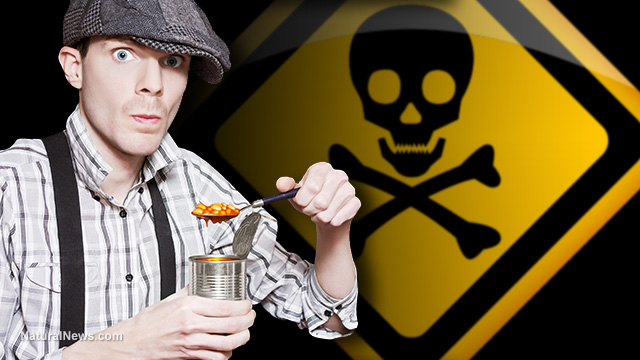
Botulism – causes, side effects and treatments at NaturalPedia.com
Wednesday, January 24, 2018 by Frances Bloomfield
http://www.naturalpedia.com/botulism-causes-side-effects-and-treatments-at-naturalpedia-com.html

Botulism, also known as botulism poisoning, is a rare yet potentially fatal illness caused by the toxins produced by the spores of Clostridium botulinum, a bacteria that occurs naturally in soil. For the most part, these spores don’t result in sickness even when the bacteria is digested. Certain conditions, however, can result in these spores growing and making the lethal toxins responsible for botulism. According to the Centers for Disease Control and Prevention (CDC), these conditions are:
- An anaerobic (oxygen-free) or low-oxygen environment
- The absence of acid, salt, or sugar
- A particular temperature range and amount of water
When all conditions are met, the chances of C. botulinum producing botulism toxins increases exponentially. Botulism toxins are categorized into seven neurotoxins designated by the letters “A” to “G”; the ones known to cause harm among humans are types “A”, “B”, “E”, and sometimes “F”. These neurotoxins affect the human body by surrounding nerves and preventing them from messages, causing affected people to lose control over their muscles.

Known side effects of botulism
There are three main kinds of botulism:
- Foodborne botulism
- Infant botulism
- Wound botulism
Foodborne botulism typically occurs when contaminated food is eaten, though inhaling spores can lead to this condition as well. Depending on how much of the bacteria was ingested, the symptoms of foodborne botulism can manifest within 12 hours of consumption of over the course of a few days. The symptoms of foodborne botulism include:
- Abdominal cramps
- Blurred or double vision
- Difficulty breathing, swallowing or speaking
- Dry mouth
- Facial weakness, including drooping eyelids
- Nausea
- Paralysis
- Vomiting
Wound botulism, which is caused by C. botulinum entering the body through cuts, displays most of these symptoms too. Only nausea, vomiting, and abdominal cramps are limited to foodborne botulism.
Infant botulism, on the other hand, is the result of C. botulinum spores growing in the intestinal tract of a baby after eating contaminated foods (such as honey or corn syrup). Babies as young as six days old can be affected by infant botulism, the symptoms of which typically occur within 18 to 36 hours after the consumption of contaminated food. These symptoms are:
- Constipation
- Difficulty feeding
- Drooling
- Drooping eyelids
- Exhaustion
- Floppy movements
- Irritability
- Trouble controlling the movement of the head
Body systems harmed by botulism
The three main types of botulism primarily impact the muscles. If not treated immediately, however, then botulism can affect other areas of the body and cause the infected person experience the various symptoms listed above. These include but aren’t limited to the digestive system (as evidenced by symptoms of vomiting, diarrhea, and constipation) and the respiratory system.
Infant botulism is slightly different in that the first system to undergo changes is the digestive system, as constipation is the first symptom of this disease.
Food items or nutrients that may prevent botulism
When it comes to foodborne botulism, many past cases of this disease were brought on by the consumption of home-canned, preserved, or fermented foods that weren’t canned properly. As such, there are numerous steps that can be taken to prevent this from happening:
- Using pressure canners in storing low-acid foods, as home canning is the most common source of foodborne botulism. Some examples of low-acid foods include asparagus, beets, potatoes, and corn.
- Either keeping aluminum foil-cooked and wrapped potatoes hot or refrigerating them immediately. This is because the potatoes and aluminum foil can form an environment free of oxygen, allowing botulism to thrive.
- Refrigerating herb- or garlic-infused homemade oils. Make it a point to throw away unused oils after four days.
- Boiling food for 10 minutes in order to destroy C. botulinum.
- If any cans of commercially prepared food are open or bulging, toss these out right away.
- Remaining wary of fermented fish and other aquatic foods. In Alaska, fermented seafood is one of the leading causes of foodborne botulism.
- Avoid giving babies under one year of age honey or corn syrup.
Treatments, management plants for botulism
The treatment for botulism is largely related to which type a person has. For instance, foodborne botulism and wound botulism are usually treated with an antitoxin following diagnosis, while infant botulism is treated with botulism immune globulin to block the botulism neurotoxins in the blood. Wound botulism may also call for the removal of infected tissue. For the more severe cases of botulism, a ventilator may be necessary in order to support breathing.
Note that any paralysis that occurs as a result of botulism can’t be reversed through treatment. The most that can be done is preventing it from getting worse. However, most people who experienced paralysis because of botulism and prior to treatment eventually showed signs of improvement over the course of weeks or months. In these cases, long-term therapy and rehabilitation may be recommended.
Where to learn more
- Botox Injections Can Leak Botulism Toxin Into the Brain, Warn Scientists
- GMOs in water supply may be behind Fronterra botulism scare in New Zealand
- Mother of three contracts BOTULISM from disgusting gas station nacho cheese
- Nacho cheese sauce responsible for sending 10 people to the hospital with BOTULISM
- Shortcuts can kill: Learn how to can food correctly for healthy, long-term food storage
Summary
Botulism is a rare but dangerous disease caused by the toxins of the bacteria C. botulinum. There are three main types of botulism: foodborne botulism, infant botulism, and wound botulism. All types of botulism are characterized by muscle weakness, blurred or double vision, drooping eyelids, and difficulty swallowing. If left untreated, then paralysis or even death can occur. Botulism is preventable, as it’s commonly caused by the consumption of food that hasn’t been properly canned or fermented, or by feeding infants corn syrup or honey.
Sources include:
Tagged Under: Tags: botulism





